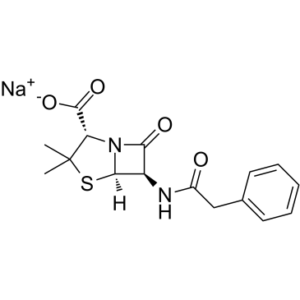Penicillin G sodium
This product is for research use only, not for human use. We do not sell to patients.

For small sizes, please check our retail website as below: www.invivochem.com
| Size | Price | Stock |
|---|---|---|
| 5g | $645 | Check With Us |
| 10g | $1100 | Check With Us |
| 20g | $1650 | Check With Us |
Cat #: V5329 CAS #: 69-57-8 Purity ≥ 98%
Description: Penicillin G sodium, the sodium salt of penicillin G, is a typical penicillin derivative and β-lactam antibiotic commonly used in the form of its sodium or potassium salts in the treatment of a variety of infections.
Top Publications Citing Invivochem Products
Publications Citing InvivoChem Products
Product Promise

- Physicochemical and Storage Information
- Protocol
- Related Biological Data
- Stock Solution Preparation
- Quality Control Documentation
| Molecular Weight (MW) | 356.37 |
|---|---|
| Molecular Formula | C16H17N2NaO4S |
| CAS No. | 69-57-8 |
| Storage | -20℃ for 3 years in powder formrr |
| -80℃ for 2 years in solvent | |
| SMILES Code | O=C([C@@H](C(C)(C)S[C@]1([H])[C@@H]2NC(CC3=CC=CC=C3)=O)N1C2=O)[O-].[Na+] |
| Synonyms | NSC 402815; OK 431; Pen-A-Brasive; Penicillin G sodium; Monosodium benzylpenicillin; Mycofarm; Novocillin; |
| Protocol | In Vitro | The Ultraviolet-visible (UV-Vis) absorption spectrum of the Penicillin G sodium salt-TEM-1 system is markedly different to that of Penicillin G sodium salt and TEM-1 β-lactamase, indicating the formation of new complexes between Penicillin G sodium salt and TEM-1 β-lactamase. |
|---|---|---|
| In Vivo | In the logistic regression model, the probability of a positive swab in the control group is 1.6 times higher than that in the pigs treated with Penicillin G sodium salt (P<0.05). In the control group, the risk of a swab having 10 to 99 colonies per plate, compare to having zero per plate, is 2.3 times greater than that in the pigs treated with Penicillin G sodium salt (P=0.022). |
These protocols are for reference only. InvivoChem does not
independently validate these methods.
| Solvent volume to be added | Mass (the weight of a compound) | |||
|---|---|---|---|---|
| Mother liquor concentration | 1mg | 5mg | 10mg | 20mg |
| 1mM | 2.8061 mL | 14.0304 mL | 28.0607 mL | 56.1214 mL |
| 5mM | 0.5612 mL | 2.8061 mL | 5.6121 mL | 11.2243 mL |
| 10mM | 0.2806 mL | 1.4030 mL | 2.8061 mL | 5.6121 mL |
| 20mM | 0.1403 mL | 0.7015 mL | 1.4030 mL | 2.8061 mL |
The molarity calculator equation
Mass(g) = Concentration(mol/L) × Volume(L) × Molecular Weight(g/mol)
Mass
=
Concentration
×
Volume
×
Molecular Weight*
The dilution calculator equation
Concentration(start)
×
Volume(start)
=
Concentration(final)
×
Volume(final)
This equation is commonly abbreviated as: C1 V1 = C2 V2
Concentration(start)
C1
×
Volume(start)
V1
=
Concentration(final)
C2
×
Volume(final)
V2
Step One: Enter information below
Dosage mg/kg
Average weight of animals g
Dosing volume per animal µL
Number of animals
Step Two: Enter the in vivo formulation
%DMSO
+
%
+
%Tween 80
+
%ddH2O
Calculation Results:
Working concentration:
mg/ml;
Method for preparing DMSO master liquid:
mg
drug pre-dissolved in
µL
DMSO(Master liquid concentration
mg/mL)
,Please contact us first if the concentration exceeds the DMSO solubility of the batch of drug.
Method for preparing in vivo formulation:
Take
µL
DMSO master liquid, next add
µL
PEG300, mix and clarify, next add
µL
Tween 80,mix and clarify, next add
µL
ddH2O,mix and clarify.
Note:
- (1) Please be sure that the solution is clear before the addition of next solvent. Dissolution methods like vortex, ultrasound or warming and heat may be used to aid dissolving.
- (2) Be sure to add the solvent(s) in order.




































